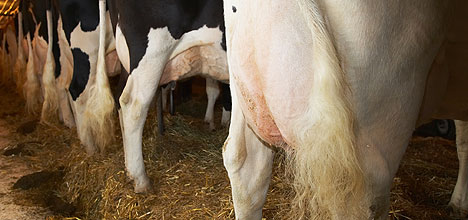A new regional council effluent monitoring system for dairy farmers is being welcomed by Waikato Federated Farmers president James Houghton.
The trial system to monitor compliance with effluent management rules is a way for the Waikato Regional Council to work with farmers to see that they are compliant and is a positive step forward, says James.
The regional council says the trial will involve more ground-based work with farmers to identify and fix problems, and less random helicopter monitoring of dairy farms.
Previously, the council has largely relied on complaints from the public, and helicopter monitoring of farms chosen at random, to detect breaches of effluent management rules which can result in the pollution of waterways.
The plan for the 2012-13 season is to target up to 500 farms in areas with soils that are seen as having a greater risk of allowing effluent to get into waterways.
Those farms will be flown over by a helicopter to identify any potential serious non-compliance.
Once any serious non-compliance is dealt with, the rest of the properties in the group will also be inspected.
The exact boundaries of the high risk areas aren't being disclosed in advance.
But farmers who will be visited at some stage during the season are being informed of this in writing and will receive a phone call shortly before a council officer arrives for a ground-based inspection.
When the officer does eventually visit for the ground-based inspection they will identify any problems with the farmer's effluent system and, if necessary, make a formal direction for improvements to be made.
After recent work with the dairy industry, the council will now be in a position to tell the farmer to work with effluent system companies accredited under DairyNZ's farm dairy effluent code of practice and design standards.
James says the trial is the result of regular meetings between Federated Farmers, DairyNZ and Fonterra which had identified potential issues and ways of addressing them.
The aim of everyone is to reduce or prevent effluent getting into water ways, says James.
While most farmers have invested in modern effluent ponds and systems to irrigate waste onto pasture, James says around 10 per cent of the Waikato's dairy farms still operated two pond eluent systems.
'Time is limited for those two pond systems.”
The Waikato has received six months' of rain in the past two and a half months and the extremely wet conditions has resulted in the failure of some pond systems but James says those farmers who let council know they had a problem have found staff willing to work to help them through that.
Helicopters may still be used outside the higher risk soil zones for random monitoring as required.
The new way of doing things is not expected to cost any more.
'The change to a more ground-based strategy sees us moving from a random system of compliance monitoring, to a targeted monitoring regime under which we are now able to direct farmers to farm specific advice about compliance from a code of practice-accredited designer,” says compliance and education manager Rob Dragten.
'In the past, farmers haven't always had access to guidance on what constitutes a good effluent management system. Now the dairy industry has developed the new code and formally accredits those designers qualified to apply its standards properly.
'The new arrangements mean we can trial our different approach to compliance monitoring, involving us working with farmers more to sort things out. Naturally we'll still take formal enforcement action where necessary against farmers, as we have in the past.
'Another advantage of our new system is that there will be targeting of farms in areas where soils are seen as having a higher risk of allowing effluent to get into waterways. These higher risk soils include, for example, those with impeded drainage or infiltration rates, soils with a very coarse structure and land with a slope of over seven degrees.
'Targeting higher risk soil areas is a bit like paying more attention to roads with higher crash rates when you're trying to reduce the road toll.”
The council has a strong focus on preventing untreated dairy farm effluent from entering waterways.
'Many farmers have shared our environmental protection goal and have done much to protect water quality, including upgrading effluent systems. Fonterra and DairyNZ have also worked with us closely to improve the industry's environmental performance in the Waikato.
'Our combined strategies have been helpful in making progress over the years. We've been holding reasonably steady with dairying's environmental performance lately. Now the council is hoping its new, more targeted approach will make further gains.
'Effluent in waterways can have a serious impact on aquatic life and make people sick, so it's important to have effective effluent management systems. Many farmers have put a considerable effort into getting their systems up to speed and we want to ensure the inaction of others doesn't dilute all their good work.”



3 comments
HALF HEARTED EFFORT HERE
Posted on 01-09-2012 18:29 | By YOGI
Elsewhere in NZ there are not "trials" the Regional COuncil actually visits each farm every year and helps/advises farmers to get it right. Waikato RC are just throwing the toys out of the cot after the event to date by rolling out the lawyers, not really very preventative. They could learn a lot from the likes of New Plymouth I reckon.
NZ Farming System
Posted on 02-09-2012 10:55 | By [email protected]
I doubt very much that is a picture of NZ Cows, they still have tails and look nicely groomed and housed. The NZ Dairy system of farming is in my opinion, harsh. There is to much reliance on the weather. Cows stood out in all weathers, up to their Hocks in mud, cold temperatures, and basic maintenance food rations. If Cows are fed more hard feed, dung is easier to deal with, instead of turning everything into slurry which run into water ways. Time to wake up and house your Calving stock in sheds in the winter.
Cattle in waterways is commonly seen
Posted on 02-09-2012 15:55 | By Can do it
Drive for an hour in any direction and anyone can see the bulk of farmers grazing pasture that has streams and headwaters/springs in them that the cattle/cows are forced to eat out of and therefore create tremendous damage to the streams ecosystem, erosion issues and of course effluent DIRECTLY into such waterways. I will believe that the authorities are genuine in their compliance enforcement when these streams are no longer exposed to being stood in and shat and urinated directly into.
Leave a Comment
You must be logged in to make a comment.